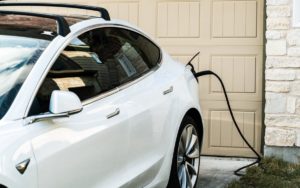Findings from a recent California study show that EVs can drive down prices for electricity. Could the same findings be seen with EV adoption in Canada as well?

According to the report, because there are caps on the amount of revenue that utilities are allowed to generate, all that extra money cannot end up in the pockets of the utility companies, but instead is returned to customers in the form of reduced rates.
Findings from a recent California study show that EVs can drive down prices for electricity. Could the same findings be seen with EV adoption in Canada as well?
Canadian utility operators and their customers take note. Adoption of more electric vehicles is helping to reduce electricity rates in California, according to a recent study by Synapse Energy Economics, an Environmental consulting firm based in Massachusetts.
The report, entitled Electric Vehicles Are Driving Rates Down, looked at three California utility companies that served more than 735,000 households with EVs. When looking at the costs of providing electricity to those vehicles, compared with the revenue generated by them, the results showed that between 2012 and 2021, the utilities made $1.7 billion in excess profit.
According to the report, which was funded in part by the Natural Resources Defense Council, because there are caps on the amount of revenue that utilities are allowed to generate in the Golden State, all that extra money cannot end up in the pockets of the utility companies, but instead is returned to customers in the form of reduced rates.
“The results of our analysis indicate that, across three of the service territories serving the most EVs in the United States, EVs have increased utility revenues more than they have increased utility costs, leading to downward pressure on electric rates for EV owners and non-EV owners alike,” says the study.
Similarities with Canada
Although the study was set in California, “by and large” most of the findings and implications from them can also be “applied to Canada,” says Benoit Marcoux, executive advisor at LxNGen and ChargeHub in an interview with Electric Autonomy.
Every province in Canada, like certain states in the U.S., also has a regulatory body that approves the rates of electricity set by the utility provider and restricts them from making more money than their capital costs.
“When you look at adding EVs to the grid, it essentially costs less to serve that EV from a utility perspective,” says Marcoux.
A big reason why, Marcoux says, is because while EV customers do tend to consume significantly more electricity than the average consumer (an estimated increase of roughly 260 kWh per month in California), their consumption is spread over time and primarily takes place during off-peak hours, such as overnight.
“By charging during off-peak hours, EVs impose minimal costs on the grid and help to utilize resources more efficiently,” reads the study.
Additionally, because peaks of EV charging are not the same peak as the rest of the utility’s overall load, there is sufficient grid capacity, saving utilities cost on significant upgrades to their infrastructure, says Marcoux.
Flexibility with time-of-use rates
On top of that, another reason EVs are a cost-benefit for utilities is that they are “flexible loads,” says Marcoux.
“It’s like your cell phone. You’re not waiting for your cell phone to charge at 100 per cent before you leave home, at 70 per cent it’s good enough. Same thing with a car. The fact that it is flexible means that utilities can influence people charging the vehicle.”
In California, utilities have a time-of-use rate structure that includes a high-priced, on-peak period; a low-priced, off-peak period and an in-between, mid-peak period.
This is a similar rate structure utilized in Ontario, too.
Time-of-use rates are an effective way for utilities to meet peak electricity demand during either the hottest or coldest days of the year, without having to build out a lot more infrastructure to meet capacity, says Daniel Carr, head of smart cities at Alectra Utilities, the electricity provider for several Ontario municipalities west of Toronto. Additionally, consumers can purchase electricity at lower costs during these off-peak hours.
“If you can just encourage customers to not need to consume during those hours, then you can avoid that additional cost. And so pricing is an effective tool to give to customers to encourage them to consume in some hours and not consume in other hours.”
He adds the load will see alternating peaks and valleys as EV adoption grows and more electricity is utilized.
“If you go from having just one peak, and then you provide a bunch of incentives to push people off the peak and everyone responds to it, but then it creates a second [peak]. At a certain point, you will have to build more infrastructure to be able to meet that new peak but it’s a matter of trying to defer that as much as possible and to limit the size of it,” says Carr.
Quebec is starting to also implement time-of-use pricing to encourage more efficient use of energy, and other jurisdictions in North America are beginning to do the same.
“In a nutshell because [EV charging] is flexible, then utilities can use that to reduce further the cost to serve that new load,” says Marcoux. “You don’t even need [time-of-use rate] for EVs to make sense, it just helps even further.”
The California study can be found here.






